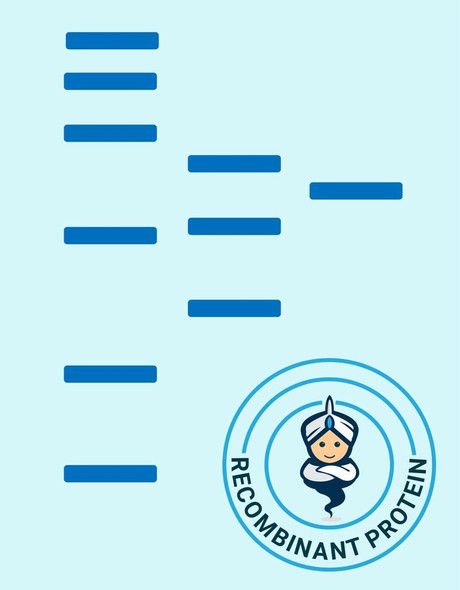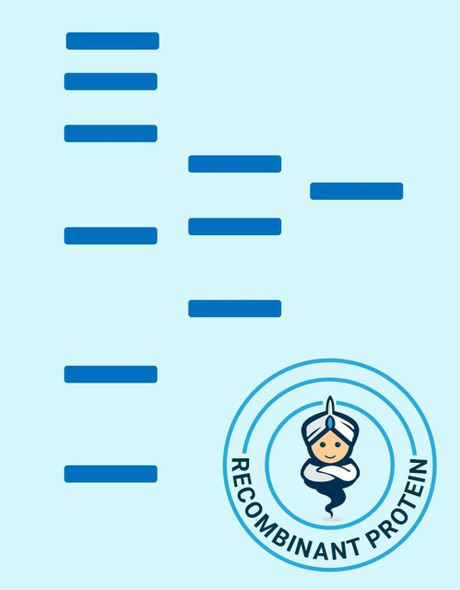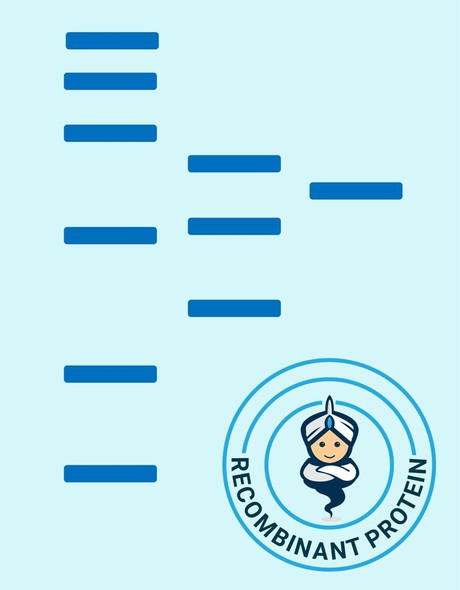Description
| Product Name: | Human TXN1 Recombinant Protein |
| Product Code: | RPPB5047 |
| Size: | 25µg |
| Species: | Human |
| Target: | TXN1 |
| Synonyms: | Thioredoxin, ATL-derived factor, ADF, Surface-associated sulphydryl protein, SASP, TXN, TRDX, TRX, TRX1, MGC61975, DKFZp686B1993. |
| Source: | Escherichia Coli |
| Physical Appearance: | Sterile filtered colorless solution. |
| Formulation: | TXN1 solution containing 1x PBS pH 7.4. |
| Stability: | Store at 4°C if entire vial will be used within 2-4 weeks. Store, frozen at -20°C for longer periods of time. For long term storage it is recommended to add a carrier protein (0.1% HSA or BSA).Avoid multiple freeze-thaw cycles. |
| Purity: | Greater than 95.0% as determined by SDS-PAGE. |
| Amino Acid Sequence: | MGSSHHHHHH SSGLVPRGSH MVKQIESKTA FQEALDAAGD KLVVVDFSAT WCGPCKMIKP FFHSLSEKYS NVIFLEVDVD DCQDVASECE VKCMPTFQFF KKGQKVGEFS GANKEKLEAT INELV |
| Biological Activity: | Specific activity is 7-10 A650/min/mg, obtained by measuring the increase of insulin precipitation in absorbance at 650 nm resulting from the reduction of insulin. |
Thioredoxins are small disulphide-containing redox proteins (within the conserved Cys-Gly-Pro-Cys active site) that have been found in all the kingdoms of living organisms. Thioredoxin contains a single disulfide active site and serves as a general protein disulphide oxidoreductase. Thioredoxins are involved in the first unique step in DNA synthesis. It interacts with a broad range of proteins by a redox mechanism based on reversible oxidation of two cysteine thiol groups to a disulphide, accompanied by the transfer of two electrons and two protons. The net result is the covalent interconversion of a disulphide and a dithiol. It has been suggested that thioredoxin may catalyze the formation of correct disulfides during protein folding because of its ability to act as an efficient oxidoreductant. Trx also provides control over a number of transcription factors affecting cell proliferation and death through a mechanism referred to as redox regulation.
Thioredoxin Human Recombinant produced in E.Coli is a single, non-glycosylated, polypeptide chain containing 125 amino acids (1-105 a.a.) and having a molecular mass of 13.9 kDa (Molecular weight on SDS-PAGE will appear higher). TXN protein is fused to a 20 amino acid His-Tag at N-terminus and purified by standard chromatography.
| UniProt Protein Function: | RRas: a small G protein of the Ras family. Promotes focal adhesion formation by signaling to FAK and p130(Cas). Promotes tumor growth of cervical epithelial cells and increases their migration potential over collagen through a pathway that involves PI 3-K. |
| UniProt Protein Details: | Protein type:G protein, monomeric, Ras; Motility/polarity/chemotaxis; G protein, monomeric; G protein Chromosomal Location of Human Ortholog: 19q13.33 Cellular Component: focal adhesion; plasma membrane Molecular Function:GDP binding; GTPase activity; protein binding; protein complex binding Biological Process: leukocyte differentiation; positive regulation of angiogenesis; Ras protein signal transduction; regulation of protein kinase B signaling cascade |
| NCBI Summary: | The protein encoded by this gene is a small GTPase involved in diverse processes including angiogenesis, vascular homeostasis and regeneration, cell adhesion, and neuronal axon guidance. Mutations in this gene are found in many invasive cancers. [provided by RefSeq, Jul 2015] |
| UniProt Code: | P10301 |
| NCBI GenInfo Identifier: | 133486 |
| NCBI Gene ID: | 6237 |
| NCBI Accession: | P10301.1 |
| UniProt Secondary Accession: | P10301,Q6FH12, |
| UniProt Related Accession: | P10301 |
| Molecular Weight: | 23,480 Da |
| NCBI Full Name: | Ras-related protein R-Ras |
| NCBI Synonym Full Names: | related RAS viral (r-ras) oncogene homolog |
| NCBI Official Symbol: | RRAS�� |
| NCBI Protein Information: | ras-related protein R-Ras |
| UniProt Protein Name: | Ras-related protein R-Ras |
| UniProt Synonym Protein Names: | p23 |
| Protein Family: | Ras-related protein |
| UniProt Gene Name: | RRAS�� |
| UniProt Entry Name: | RRAS_HUMAN |






